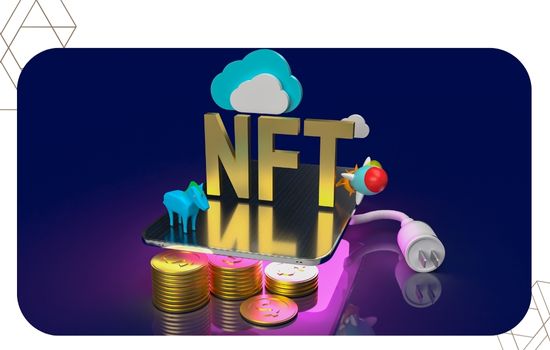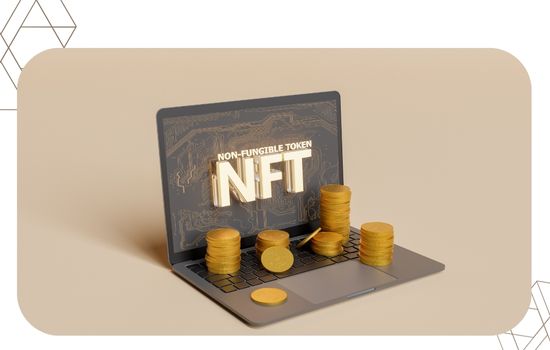Advertisements
From the front line: What is NFT technology and how does it work?To understand this, a clear summary is provided:

We will define the concept, explain its mechanism, explore practical cases, show current statistics, offer two original examples, and present an analogy to facilitate understanding.
Finally, we will analyze challenges and the future outlook.
What does “NFT” really mean?
An NFT (short for non-fungible tokenA token (or non-fungible token) represents a unique digital asset, registered on a blockchain network.
Unlike cryptocurrencies that are interchangeable with each other (such as Ethereum), each NFT has a unique identity and cannot be replaced by another of the same type.
Advertisements
This digital recognition allows you to prove ownership, authenticity or a special right over a digital resource (work of art, video, audio file) or even a physical one.
Therefore, when asking What is NFT technology and how does it work?We are talking about an infrastructure that enables digital individualization, guarantees originality, and transferability.
How does it work in practice?
The operation of an NFT involves several key steps:
Minting, chain registration, metadata attribution, marketplace trading, and, in some cases, resale with royalties. In essence:
- A creator “mints” the token on a blockchain.
- This coinage associates a unique identifier with metadata (digital file, description, rights).
- The network records current ownership and future transfers.
- A buyer acquires the NFT and becomes the digital owner of the token.
- In resale, a smart contract can be applied that automatically distributes a commission to the original creator.
This process deploys consensus technology, distributed verification, and permanent recording, which guarantees (within its design) traceability and immutability.
So, when one investigates What is NFT technology and how does it work?It is worth noting that at its core is a decentralized trust network that does not depend exclusively on traditional intermediaries.
What are NFTs used for today?
The usefulness of NFTs has evolved a lot since their beginnings as purely speculative collecting.
By 2025, they will already be used in multiple sectors. Here are three key areas of application:
Digital art and collectibles.
It allows artists to digitize works with a clear chain of custody; in addition, resale can include automatic royalties.
Video games and the metaverse.
In virtual environments, NFTs act as assets that players actually own (skins, terrains, avatars).
According to recent statistics, the global NFT market is estimated at approximately $34.1 billion in 2025.
Tokenization of physical assets or digital rights.
For example, an access right, a contract, or a fraction of real property can be transformed into an NFT that is traded or managed digitally.
Original examples to illustrate
Example AImagine a Mexican photographer who creates a series of nature images and labels them as NFTs.
Each image includes limited printing rights, and the series itself includes a benefit: when resold, the creator automatically receives 10 % of the resale value.
This allows monetization and participation in the secondary market, without relying solely on physical galleries.
Example BIn the real estate sector of a Latin American city, a company tokenizes fractions of a vacation apartment property.
Each fraction translates into an NFT that represents the right to rental income.
Investors acquire tokens and receive dividends automatically via smart contract, without going through complex intermediaries.
The analogy that helps to understand
For better viewing What is NFT technology and how does it work?Imagine that each NFT is a unique “digital ownership” card, as if each physical object had an official certificate in a public display case:
This certificate is transferable, has a visible history, and allows the holder to prove that they are the legitimate owner.
Just as a physical work of art comes with a certificate of authenticity, an NFT is that certificate + a digital blockchain record.
Benefits and added value
Adopting NFTs generates concrete advantages:
- Greater transparency: every transaction is recorded and can be audited.
- Empowering the creator: recurring royalty income.
- Real ownership by the user: not just a license, but verifiable ownership.
- Asset diversification: allows participation in previously inaccessible portions of assets.
- Innovation in business models: memberships, exclusive access, special experiences linked to NFTs.
Read more: Blockchain beyond cryptocurrencies: real-world applications
Challenges and risks that must be considered
Despite its potential, the technology is not without its challenges:
- Regulation still unclear: issues of copyright, taxation and digital jurisdiction generate uncertainty.
- For example, one study indicates that intellectual property legal frameworks are more suitable for governing NFTs than traditional sales laws.
- Fraud and “cybersquatting”: thousands of collections that mimic legitimate projects have been detected, with scams that have already affected hundreds of thousands of victims.
- Value volatility: although part of the market matures, there is still strong speculation and risk of loss of value due to lack of utility.
- Scalability and cost: as with other blockchain applications, transaction costs and energy footprint can be obstacles.
- User understanding: many still confuse licenses with actual ownership or are unaware of the legal implications.
Why should you consider NFTs as an option?
If you are a creator, investor, or entrepreneur, understand What is NFT technology and how does it work? It makes it possible to get ahead of the curve and take advantage of new value models.
By integrating NFTs:
- It can open up new avenues for monetizing your creations.
- You can diversify investments in technically supported digital assets.
- You can build loyalty in communities with exclusive token-based experiences.
Likewise, adopting it prudently involves clearly defining the purpose (utility, community, value) beyond mere “hype”.- This reduces the risk of the investment turning into a loss due to a disconnect between the token and its real utility.
Conclusion
To recap: What is NFT technology and how does it work? It is a question whose understanding opens doors to a digital age where ownership, exchange, and value are reinvented.
We have seen the definition, the mechanism, the applications, concrete examples, and the analogy that facilitates its visualization.
At the same time, we analyze the benefits and challenges you should consider.
In 2025, NFTs are no longer just "images to auction"; they are becoming infrastructure of value.
You have the opportunity to join in an informed and strategic way. Whether it's to create, invest in, or transform business models, the time is now.

Read more: Advantages and disadvantages of the metaverse in 2025
Frequently Asked Questions
Is an NFT the same as a digital work of art?
Not necessarily. An NFT can represent a digital work of art, but it can also represent a fractional ownership, an access right, or a physical asset tied to a token.
The value lies in the utility and verification, not just in the art.
Who regulates NFTs or protects the buyer?
Currently, there is no single global supervisory body for NFTs.
Protection depends on smart contracts, platform terms, the country's legal system, and market practices.
Therefore, it is essential to review the platform's licenses, rights, and reputation.
Do I need to know about code or blockchain to participate?
No. Many platforms offer user-friendly interfaces for creating, buying, or selling NFTs without in-depth technical knowledge.
However, a basic understanding of digital wallets, network fees, and key management improves the experience and reduces risks.
Will all NFTs decrease in value?
No. The value of an NFT depends on utility, demand, community, and scarcity. While there have been declines in certain assets, the market as a whole projects significant growth.
For example, reports estimate that the global NFT market will grow in the coming years with a CAGR of 30% between 2025 and 2029.
Can I convert an NFT into a tangible asset?
Yes, in many projects the token is linked to a physical good, a service, or an experience.
The important thing is that this link is well defined legally and in the token's metadata.